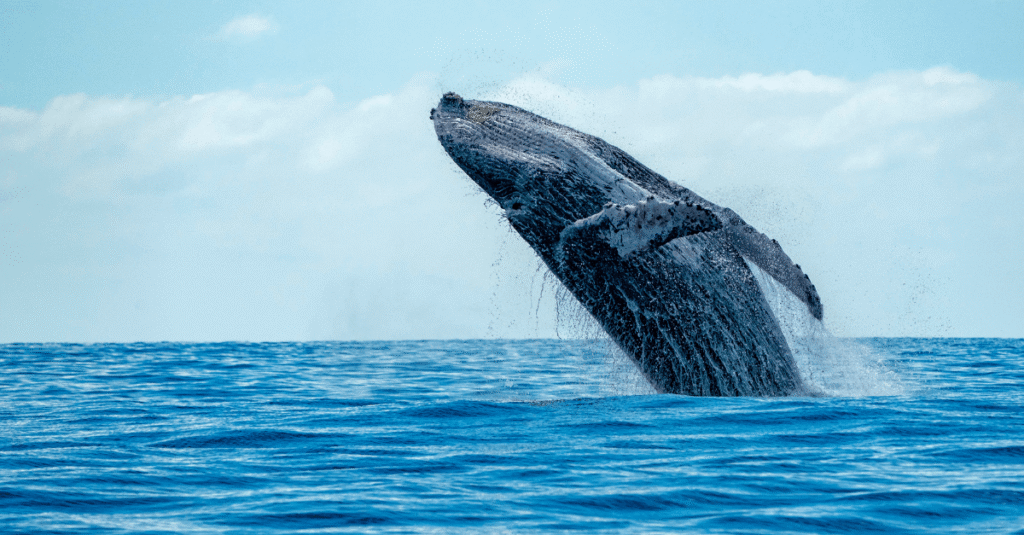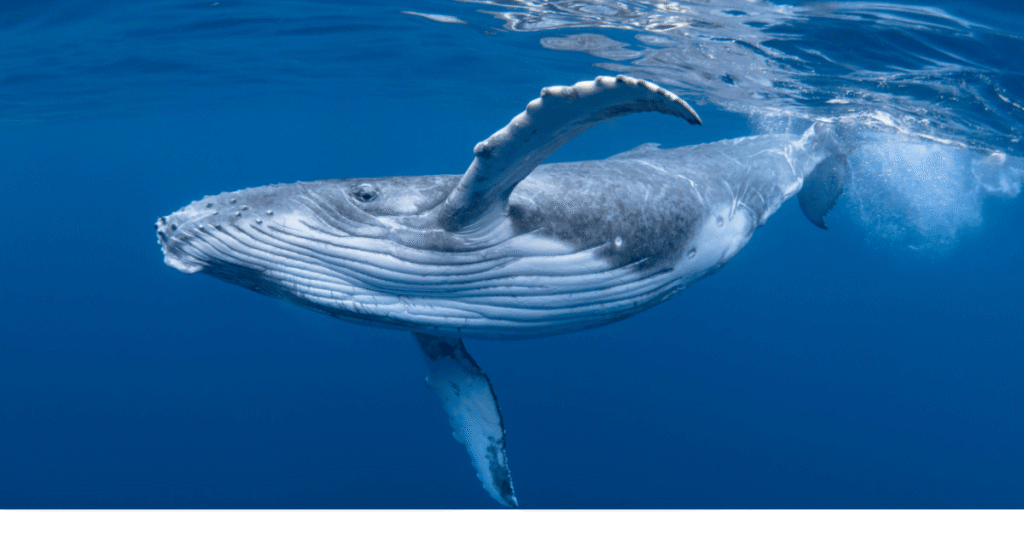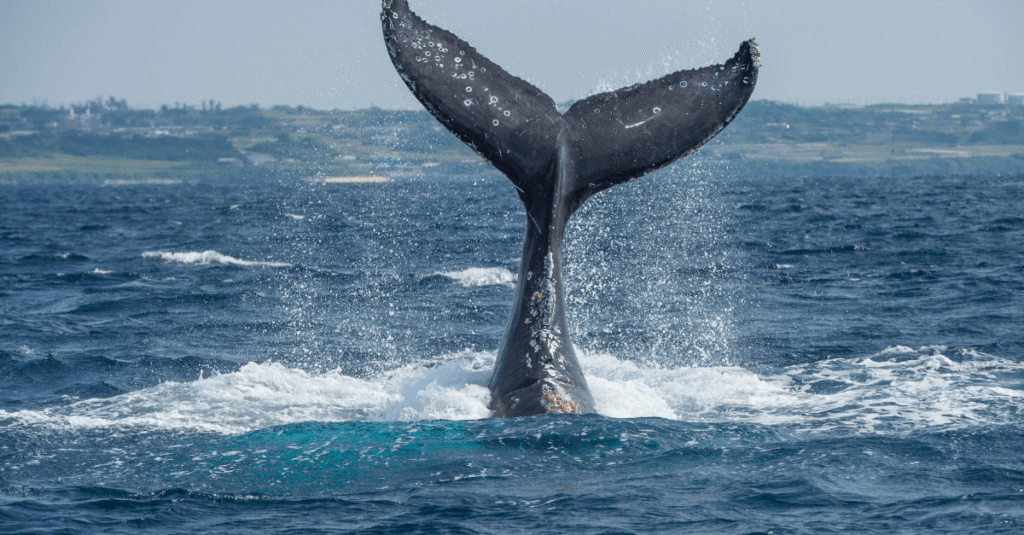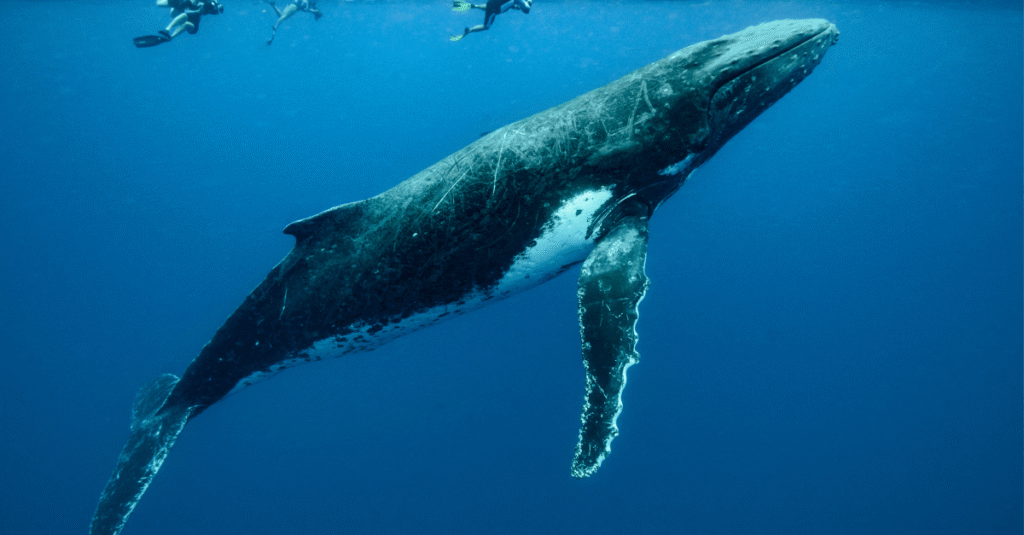Imagine you are floating at the bottom of a deep, calm ocean. All around you are endless blue waters, where sunlight fears to reach. In this infinite emptiness, a solemn, harmonious, and powerful sound wave suddenly shakes your body and soul. This is no ordinary sound; it is the song of the blue whale, the largest animal living on Earth. For millions of years, this song has floated from one end of the ocean to the other, searching for a mate, showing the way and announcing its existence.
But today, there has been a strange change in that song. Scientists are noticing that the iconic song of the blue whale is gradually becoming weaker and deeper. As if a great singer is losing the strength of his voice. This phenomenon is called “blue whales going silent”.

Background: The ocean’s lone singer
The blue whale (Balaenoptera musculus) is not only the largest animal on earth, it is also one of the most mysterious. At nearly 100 feet long and weighing 200 tons, this massive creature lives largely alone. They use a special type of low-frequency sound, or song, to communicate with other whales hundreds, even thousands, of kilometers away.
Importance of blue whale song:
- Communication and reproduction: This song is the male whale’s main way of finding a mate. The melody and strength of the song indicate his well-being and reproductive capacity.
- Navigation: They use these sound waves to locate themselves in the vast ocean and travel long distances.
- Environmental insights: Their songs help them communicate information about the structure of the seabed and the environment.
This song is so powerful that, under favorable conditions, it can reach from one ocean to another. Scientists have been recording this song for decades, which has helped them understand their numbers, movements, and behavior. But since the 1960s, a worrying change has been observed in the records—the pitch or sharpness of their songs has decreased by about 30%. That is, their voices are gradually becoming deeper or heavier.
The beginning of silence: What is happening to blue whale songs?
When we say “going silent,” we do not mean that the whales have stopped singing completely. Rather, the main characteristics of their songs are changing. The frequency at which they used to sing has now dropped much lower.
Think of it this way: an opera singer who used to sing loudly now lowers his voice. While this may seem like a minor change, the reasons behind it are complex and can be devastating to marine ecosystems.
This change is not limited to blue whales in a specific region. Similar trends have been observed in blue whales from the Atlantic to the Pacific, and even in the Indian Ocean. It is a global phenomenon that has scientists puzzled. Why this sudden change in habits that have lasted for millions of years?
Blue Whales Going Silent: Why the Mysterious Change? Causes…

Scientists have yet to pin down a single cause. But there are several strong theories that help to shed light on the mystery.
Theory 1: Increasing Ocean Noise Pollution
Our planet’s oceans are no longer as peaceful as they once were. Over the past century, human activity has made the seas a noisy place.
- Ship Noise: The sound of the engines and propellers of millions of ships plying international trade creates a constant hum. The frequency of this noise often matches the frequency of whale songs, which interferes with their communication. This is called “acoustic masking.” It’s like talking at a noisy party where you can’t hear the people next to you unless you shout. Whales may be trying to avoid this noise by changing the pitch of their songs to a frequency where the noise from ships is less.
- Seismic Surveys: Seismic surveys are conducted using powerful air guns to search for oil and gas on the seabed. These air guns produce intense sound waves every 10-15 seconds, which travel hundreds of kilometers. This sudden and intense sound disrupts the whales’ normal behavior, can damage their hearing, and in extreme cases can even cause death.
- Military Sonar: The active sonar technology used by the Navy to detect submarines produces incredibly loud sounds. This sound causes the whales to panic, and they are forced to dive or surface quickly. Which can cause them to suffer from serious physical problems such as “decompression sickness,” or the bends.
Due to this increasing noise pollution, whales are having to adapt to make their songs more effective. By lowering the pitch, they may want their message not to be drowned out by this artificial noise.
Theory 2: Population Growth and Mate Recovery
This is a relatively optimistic theory. Blue whales were nearly wiped out by indiscriminate whaling in the 20th century. They may have had to send signals over long distances to find mates, which required high-pitched, powerful songs.
In 1986, the International Whaling Commission (IWC) banned commercial whaling. Since then, blue whale populations have been slowly increasing. According to this theory, now that they have more mates around them, they no longer need to sing as loudly or as loudly. They can now use less energy and sing at lower pitches to find mates. This is the opposite of the “Lombard effect,” where the vocalizations become louder as noise increases, and quieter as noise or distance decreases.
If this theory is true, that’s good news. This means that conservation efforts are working and whales are adapting to their new social environment.
Theory 3: Changing Ocean Chemistry
Climate change is not only affecting the atmosphere, it is also changing the chemistry of the oceans. The ocean is becoming more acidic as more carbon dioxide (CO2) is being absorbed from the atmosphere.
Some studies have shown that as water becomes more acidic, sound waves are less likely to be blocked and can travel more easily and quickly. This means that songs can now travel further with the same amount of energy. Whales no longer need to sing as loudly or at a higher pitch as they used to. They can use less energy to get their message across the same distance.
Although this theory is still in its early stages, it is an example of the far-reaching and unexpected effects of climate change.
Theory 4: Sexual Selection and Fitness
Sexual selection is a powerful driving force in the biological world. Males often use their physical prowess to attract females. In the case of blue whales, a deep or low-pitched song may be a sign of a larger and stronger male.
Since the number of larger and stronger males was reduced due to whaling, the average pitch may have been higher. Now, as the population has recovered, the number of larger and stronger males is increasing. Female whales are now having more opportunities to choose mates and may be choosing the genetically best mates, who have lower song pitches. As a result, the average song pitch has been gradually decreasing over generations.
This may be a classic example of Darwinian natural selection, where the environment and social structure influence the behavior of a species.
Why is this important to us?

The change in pitch of a giant sea creature’s song may seem far removed from our daily lives. But in reality, it carries an important message for all of us.
- A barometer of planetary health: The health and behavior of blue whales is an indicator of the health of the entire marine ecosystem. This change in their song is evidence of our increasingly negative impact on the oceans—whether it’s noise pollution or climate change.
- Loss of biodiversity: If the cause of this change is negative, such as noise pollution. It could severely affect the reproduction and survival of whales. It could push the largest animal on Earth back to the brink of extinction.
- Moral responsibility: As humans, we have a moral responsibility to the other inhabitants of this planet. Do we really want a world where our activities silence the most majestic melodies of nature?
This silence of the blue whale is actually the silent cry of the ocean. This cry is telling us that the ocean is not doing well and we are to blame.
Some common questions and answers (FAQs)
Question 1: Are blue whales really going completely silent?
Answer: No, they are not going completely silent. They still sing, but the frequency or pitch of their songs has decreased significantly over time. That is, their voices are getting deeper.
Question 2: Are humans solely responsible for this change?
Answer: Scientists are working on several theories. Man-made causes, such as marine noise pollution and changes in ocean chemistry due to climate change, are the main suspects. However, natural causes, such as population growth, may also play a role. It is likely that it is a combination of factors.
Question 3: What type of noise pollution is most harmful to whales?
Answer: The constant noise from commercial ships (shipping noise) is considered the biggest threat because it is long-lasting and widespread. However, sudden and intense noise from seismic surveys and military sonar can also be very harmful and cause immediate danger.
Question 4: Can we reverse this process?
Answer: Yes, it is possible. If noise pollution is the main cause, we can help whales by reducing it. Steps can be taken such as improving ship designs to make them quieter, reducing ship speeds, and regulating shipping in sensitive marine areas.
Question 5: How can I help as an individual?
Answer: Your role is also important.
- Raise awareness: Talk about this issue with family, friends, and social media.
- Support conservation organizations: Donate or volunteer to those working to protect marine life and the oceans.
- Be a conscious consumer: Support organizations that are environmentally responsible. Learn about the supply chain of the products you buy.
- Reduce your carbon footprint: Make small changes in your lifestyle to reduce climate change and ocean acidity.
Towards a solution: What can we do?

This change in blue whale song is a complex problem, and a global coordinated effort is needed to solve it.
International policy and regulation:
- The International Maritime Organization (IMO) should develop stricter regulations to control noise pollution.
- Financial incentives could be provided to encourage the development and use of “quieter ship” technology.
- Areas important for whale breeding and migration should be declared “Marine Protected Areas” and commercial activities should be restricted there.
Technological innovation:
- Noise can be reduced by improving the design of ship propellers and engines.
- Research and use of environmentally friendly technologies, such as “Marine Vibroseis”, as an alternative to seismic airguns for oil and gas exploration should be increased.
Research and monitoring:
- Longer-term studies of blue whale behavior and changes in their songs should be continued so that we can be more certain about the causes.
- We need to install acoustic monitoring stations in various parts of the ocean to monitor the levels of noise pollution and its effects.
Conclusion: Echoes of the Future
The song of the blue whale is not just the voice of an animal, it is the living heartbeat of our planet. When this beat changes. We should pay attention. The lowering of the pitch of their song may be an adaptation, a struggle for survival, or a signal of impending danger.
We stand at a crossroads. We can either ignore these warnings and make the ocean noisier and more polluted, or we can listen to this silent cry and correct our mistakes. If we take the right steps, if we restore the ocean to its peace. Then perhaps one day the song of the blue whale will return to its former strength.
Until that day, we need to listen. Because deep in the ocean, these vast, lonely singers are telling us a story about ourselves, about our planet, and about our collective future. Our greatest responsibility now is to hear and understand that story. Only then may future generations also have the opportunity to hear the songs of these majestic creatures.

Hi, I’m M Saif, a digital marketer with a strong focus on SEO and content writing. I help businesses improve their online visibility, drive organic traffic, and create engaging content that converts. With a results-driven approach, I work on strategies that not only boost rankings but also deliver real value to audiences.












Leave a Reply